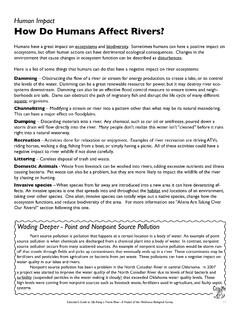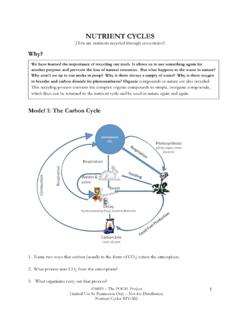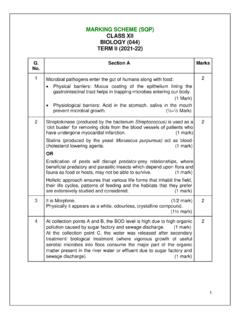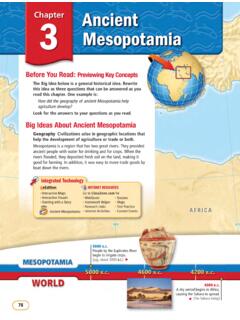Transcription of The state of the environment: water quality - GOV.UK
1 Page 1 LIT 10702 The state of the environment : water quality February 2018 Chair's foreword water keeps us alive, drives our economy and sustains wildlife. Having good water quality , managed in a way that makes sure the country is more resilient to flood and drought, is essential. As the environmental regulator the environment Agency needs to understand the complex natural and man-made systems that allow people to water crops, wash cars, take showers and drink healthy tap water wherever they live in England. This means close partnership working with water companies, farmers, businesses and environmental organisations. Over the last 30 years, there has been good progress following more than a century of poorly regulated industrial practices. England has the cleanest bathing waters since records began, serious pollution incidents are steadily declining and rivers that were biologically dead are reviving.
2 Today, the environment we live and work in faces new challenges. Climate change is causing more extreme weather, extended periods of drought punctuated by more intense rainfall events are set to become increasingly normal. It s time to redouble our efforts. There are still far too many serious pollution incidents, 317 to water in 2016. Unacceptable levels of phosphorus in over half of English rivers, usually due to sewage effluent and pollution from farm land, chokes wildlife as algal blooms use up their oxygen. Groundwater quality is currently deteriorating. This vital source of drinking water is often heavily polluted with nitrates, mainly from agriculture. water companies then have to treat water from different sources to make it safe to drink. Our ambition is a cleaner, healthier and better managed water environment .
3 Defra s 25-year environment plan challenges us to improve at least three quarters of our waters to be close to their natural state . Everyone has a part to play: the public and businesses must do more to keep plastics, fats and household chemicals out of our drains water companies must continue reducing pollution incidents from sewer systems and sewage treatment works farmers must manage their land responsibly, using fertilisers and pesticides with much greater care all the more so as the government considers new payments that increasingly reward environmental and public benefits we need water companies, businesses and volunteers to provide practical and financial support for our catchment partnerships to help rejuvenate our water environment the environment Agency will work closely with others to make this happen, but we won t hesitate to prosecute when necessary.
4 We will put things right quickly through voluntary Enforcement Undertakings for minor breaches, but the size of fines for more serious offending needs to be proportionate to turnover and consistently applied by the courts. Company boards have to take environmental risk seriously and not see it as an operational expense Page 2 LIT 10702 This report provides an assessment of water quality in England and the pressures it faces. Improving it remains one of the environment Agency s biggest and most important tasks. We can only do this by working in partnership across all sectors and society. Emma Howard Boyd, Chair of the environment Agency Key findings In 2016, 86% of river water bodies had not reached good ecological status. The main reasons for this are agriculture and rural land management, the water industry, and urban and transport pressures.
5 water quality issues were the cause of 38% of all fish test failures, and 61% of invertebrate test failures in rivers in 2015. Pollutant loads to rivers from water industry discharges have declined in recent years, with reductions of up to 70% since 1995. Over the last decade the number of serious water pollution incidents from water companies has remained broadly the same, with about 60 incidents each year. That is more than one a week. For assessed river water bodies in England, 55% were at less than good status for phosphorus in 2016. Nearly half of groundwater bodies will not reach good chemical status by 2021. For groundwaters protected for drinking water , nitrate levels were responsible for 65% of failures to achieve good chemical status. Bathing water quality has improved over the last 30 years with 98% passing minimum standards and 65% at excellent status in 2017.
6 Population growth, climate change, emerging chemicals, plastic pollution, nano-particles and fracking all present potential future threats to water quality . Page 3 water use in England water provides people and wildlife with a wide range of services. It's used for drinking,1 transporting household and industrial waste, and for recreational activities such as swimming and angling. The Office for National Statistics estimates the value of freshwaters for the whole of the UK at Our role The environment Agency: has taken over 50 million water quality samples since 1998 works in partnership with a wide range of organisations, and takes action to improve water quality by targeting point and diffuse sources of water pollution Where we want to be Work is underway to achieve the environmental objectives set out in our 2015 river basin management plans.
7 There is still work to do to achieve the planned improvements to surface waters by 2021, but projections suggest that we will meet them (table 1). Good groundwater body status will be reached by 2021 in 75% of bodies for quantitative status and 56% of bodies for chemical status. 1 Discover water . (2018) 2 Office for National Statistics. (2017) UK natural capital: ecosystem accounts for freshwater, farmland and woodland. #ecosystem-accounts-for-freshwater Page 4 Status and trends: ecological status of rivers water quality in rivers has improved markedly in recent decades (figure 1), but these improvements have not continued in recent years. There was a 1% decline in the number of rivers that were at 'good or better' biological or chemical status in 2016 compared to 2015 (figure 2).
8 'Good or better status' means that a water body is close to 'undisturbed' conditions. Biological, chemical and ecological status are assigned3 using various water quality tests. Failure of one test means that the whole water body fails to obtain good or better status. The evidence base for status classifications was upgraded in 2014. This is reflected in lower numbers of rivers achieving good or better status since then. Ecosystem effects of water quality water quality can be assessed directly by measuring the concentrations of pollutants such as nutrients and chemicals. Monitoring shows that phosphorus (a nutrient) was the most common reason for rivers not achieving good status in 2016. Of all assessed river water bodies in England, 55% were at less than good status for phosphorus. water quality can also be assessed indirectly by looking at the condition of aquatic plant and animal communities.
9 Their health depends greatly on the quality of the water . For example, high levels of phosphorus can lead to excessive growth of algae and plants, choking river channels, using up oxygen at night and adversely affecting the plants, fish and invertebrates. Of all assessed river water bodies, 56% were at less than good status for water plants and algae in 2016 and phosphorus was considered the prime cause. Of all assessed rivers, 59% were at less than good status for fish, and 26% at less than good for invertebrates. water quality issues were the cause of 38% of all fish test failures, and 61% of invertebrate test failures in rivers in 2015. 3 European Commission. Introduction to the new EU water Framework Directive Ecological status The ecological status of a water body is assigned using information from biological and physico-chemical (for example oxygen levels) testing, as well as the degree to which humans have modified its flow and structure.
10 Page 5 Status and trends: nutrients in rivers and groundwater Nutrients are a major cause of water bodies being at less than good ecological status and also affect drinking water quality . The main nutrients affecting water quality in England are phosphorus and nitrates. Phosphorus in rivers Phosphorus is the top reason for English water bodies not achieving good ecological status. It's the main cause of eutrophication in England's rivers (and lakes). High phosphorus concentrations cause excessive algal and plant growth which damages the ecology, quality and uses of waters. The main sources of phosphorus in rivers are sewage effluent and run-off from agricultural land. Phosphorus levels in rivers increased from the 1950s to the early 1990s. The trends seen in the rivers Thames and Lee are a good illustration of changes in lowland areas over this period (figure 3).
















